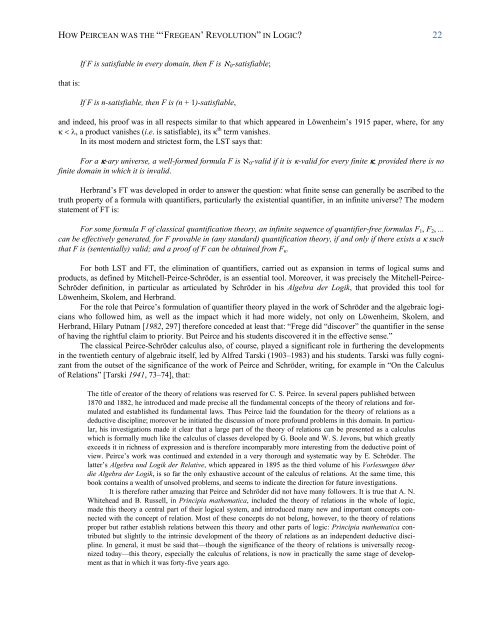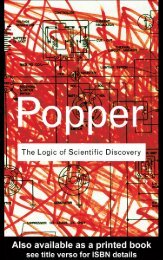Create successful ePaper yourself
Turn your PDF publications into a flip-book with our unique Google optimized e-Paper software.
HOW PEIRCEAN WAS THE “‘FREGEAN’ REVOLUTION” IN LOGIC? 22<br />
that is:<br />
If F is satisfiable in every domain, then F is �0-satisfiable;<br />
If F is n-satisfiable, then F is (n + 1)-satisfiable,<br />
and indeed, his proof was in all respects similar to that which appeared in Löwenheim’s 1915 paper, where, for any<br />
�����, a product vanishes (i.e. is satisfiable), its � th term vanishes.<br />
In its most modern and strictest form, the LST says that:<br />
For a �-ary universe, a well-formed formula F is �0-valid if it is �-valid for every finite �, provided there is no<br />
finite domain in which it is invalid.<br />
Herbrand’s FT was developed in order to answer the question: what finite sense can generally be ascribed to the<br />
truth property of a formula with quantifiers, particularly the existential quantifier, in an infinite universe? The modern<br />
statement of FT is:<br />
For some formula F of classical quantification theory, an infinite sequence of quantifier-free formulas F1, F2, ...<br />
can be effectively generated, for F provable in (any standard) quantification theory, if and only if there exists a � such<br />
that F is (sententially) valid; and a proof of F can be obtained from F�.<br />
For both LST and FT, the elimination of quantifiers, carried out as expansion in terms of logical sums and<br />
products, as defined by Mitchell-Peirce-Schröder, is an essential tool. Moreover, it was precisely the Mitchell-Peirce-<br />
Schröder definition, in particular as articulated by Schröder in his Algebra der Logik, that provided this tool for<br />
Löwenheim, Skolem, and Herbrand.<br />
For the role that Peirce’s formulation of quantifier theory played in the work of Schröder and the algebraic logicians<br />
who followed him, as well as the impact which it had more widely, not only on Löwenheim, Skolem, and<br />
Herbrand, Hilary Putnam [1982, 297] therefore conceded at least that: “Frege did “discover” the quantifier in the sense<br />
of having the rightful claim to priority. But Peirce and his students discovered it in the effective sense.”<br />
The classical Peirce-Schröder calculus also, of course, played a significant role in furthering the developments<br />
in the twentieth century of algebraic itself, led by Alfred Tarski (1903–1983) and his students. Tarski was fully cognizant<br />
from the outset of the significance of the work of Peirce and Schröder, writing, for example in “On the Calculus<br />
of Relations” [Tarski 1941, 73–74], that:<br />
The title of creator of the theory of relations was reserved for C. S. Peirce. In several papers published between<br />
1870 and 1882, he introduced and made precise all the fundamental concepts of the theory of relations and formulated<br />
and established its fundamental laws. Thus Peirce laid the foundation for the theory of relations as a<br />
deductive discipline; moreover he initiated the discussion of more profound problems in this domain. In particular,<br />
his investigations made it clear that a large part of the theory of relations can be presented as a calculus<br />
which is formally much like the calculus of classes developed by G. Boole and W. S. Jevons, but which greatly<br />
exceeds it in richness of expression and is therefore incomparably more interesting from the deductive point of<br />
view. Peirce’s work was continued and extended in a very thorough and systematic way by E. Schröder. The<br />
latter’s Algebra und Logik der Relative, which appeared in 1895 as the third volume of his Vorlesungen über<br />
die Algebra der Logik, is so far the only exhaustive account of the calculus of relations. At the same time, this<br />
book contains a wealth of unsolved problems, and seems to indicate the direction for future investigations.<br />
It is therefore rather amazing that Peirce and Schröder did not have many followers. It is true that A. N.<br />
Whitehead and B. Russell, in Principia mathematica, included the theory of relations in the whole of logic,<br />
made this theory a central part of their logical system, and introduced many new and important concepts connected<br />
with the concept of relation. Most of these concepts do not belong, however, to the theory of relations<br />
proper but rather establish relations between this theory and other parts of logic: Principia mathematica contributed<br />
but slightly to the intrinsic development of the theory of relations as an independent deductive discipline.<br />
In general, it must be said that—though the significance of the theory of relations is universally recognized<br />
today—this theory, especially the calculus of relations, is now in practically the same stage of development<br />
as that in which it was forty-five years ago.





